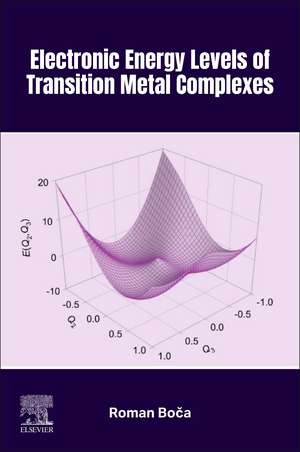Electronic Energy Levels of Transition Metal Complexes
Autor Roman Bocaen Limba Engleză Paperback – 15 noi 2024
This book includes basic formulae for matrix elements of the model Hamiltonian and a huge number of results presented as graphs identifying the order of the energy levels and their labelling using the group (double group) irreducible representations. Utilization of the generated energy levels in electron spectroscopy, electron spin resonance and magnetochemistry is presented. Massive modelling was done using the desktop computers.
- Covers advanced methodology for general cases, electronic terms and spin-orbit multiplets in the crystal field of any symmetry, and extensive modelling
- Analyzes extensive modeling of energy levels and magnetic functions fo complexes of lower symmetry
- Presents energy level diagrams and magnetic functions are presented for the most important cases, such as the octahedron, elongated tetragonal pyramid, compressed tetragonal pyramid, tetrahedron, prolate bisphenoid, flattened bisphenoid, trigonal bipyramid, tetragonal bipyramid, and o-rhombic bypyramid for d1 to d9 systems
Preț: 952.90 lei
Preț vechi: 1047.13 lei
-9% Nou
Puncte Express: 1429
Preț estimativ în valută:
182.39€ • 198.19$ • 153.31£
182.39€ • 198.19$ • 153.31£
Carte tipărită la comandă
Livrare economică 14-28 aprilie
Preluare comenzi: 021 569.72.76
Specificații
ISBN-13: 9780443334160
ISBN-10: 0443334161
Pagini: 398
Dimensiuni: 216 x 276 mm
Greutate: 0.92 kg
Editura: ELSEVIER SCIENCE
ISBN-10: 0443334161
Pagini: 398
Dimensiuni: 216 x 276 mm
Greutate: 0.92 kg
Editura: ELSEVIER SCIENCE
Cuprins
1. Symmetry
2. Electronic levels in a free atom
3. Electronic levels in a crystal field
4. Electronic spectra of transition metal complexes
5. Magnetism of transition metal complexes
6. Electron spin resonance of transition metal complexes
7. High energy spectroscopy
8. Key properties of d-electron configurations
2. Electronic levels in a free atom
3. Electronic levels in a crystal field
4. Electronic spectra of transition metal complexes
5. Magnetism of transition metal complexes
6. Electron spin resonance of transition metal complexes
7. High energy spectroscopy
8. Key properties of d-electron configurations
